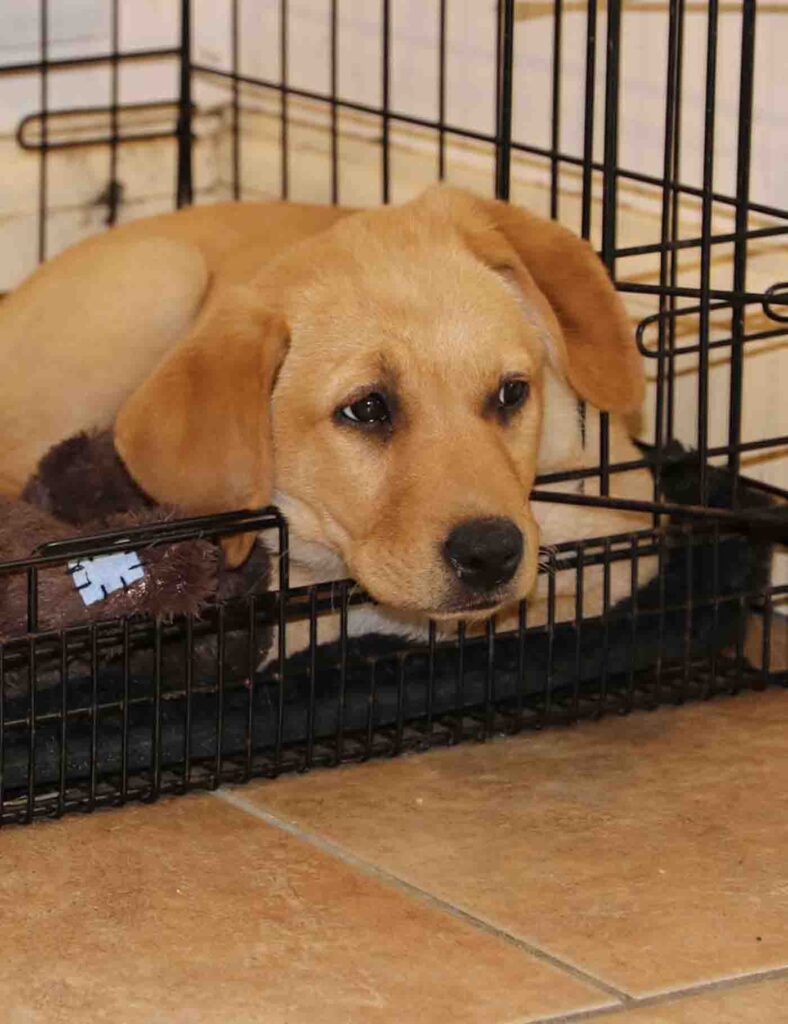Is My Dog Crate Too Small?
I love it when the time comes to fold up the crate in our kitchen and put it away for the next puppy. Dog crates take up a lot of space. Even small ones. No matter where you put them, they always seem to be in the way! And let’s be honest, they don’t look pretty.

It’s tempting to use the smallest dog crate you think you can reasonably get away with. However, a crate that is too small can cause problems such as muscle stiffness or soreness, for your Labrador. Crate training during potty training relies on the crate not being too big, but too small can be equally problematic.
It can also cause mental distress in some dogs and so it’s important to get that crate size right.
Today I’ll look at the head room and leg room required by your Lab, and help you decide if your dog crate is too small.
- Is my dog crate too small?
- Does crate size depend on the time in the crate?
- How to decide the height & width of crate you need
*The products linked in this article were carefully selected by The Labrador Site. If you decide to purchase using the links provided, we may earn a small commission on that sale. This is at no extra cost to you.
Outgrowing the puppy crate.
You were probably advised to buy a small crate for crate training your new puppy. That’s generally good advice because a small puppy in a big crate is more likely to soil their bedding.
However, that advice should have come with the additional information that you would need to buy another crate when your puppy outgrew his first one.

Is my dog crate too small?
The signs that your dog crate is too small will become apparent as the dog develops. Because this happens gradually, it is easy to miss the signs until the dog is really cramped.
The two main considerations to watch out for are headspace, and leg space.
Headspace
If a dog is standing comfortably with their weight evenly distributed between all four paws, the natural head position of that dog is raised above the shoulders.
If the top of your dog’s head, or the tips of their ears, are pressed against the roof of the crate, then your dog crate is too small.
A dog that wants to stand up in their crate should not have to hang their head in order to do so. If forced to stand with their head level with their shoulders the weight of your dog is being overloaded on the front quarters. This means that your dog is likely to experience neck muscle stiffness and soreness after being crated.
Check your dog in the sitting position too, the same rule applies. There needs to be space between the top of the head (or the tips of the ears in dogs with upright ears) and the bars of the crate.
Legspace
Dogs will curl up in a ball if they are cold, but most Labs like to sleep stretched out on their sides once they are completely relaxed.
This means that your crate must be wide enough to accommodate your dog’s body in this position. If your dog cannot straighten their legs out when lying on their side in the crate, then the crate is too small.
For an adult Labrador a 42 inch crate(paid link)* is usually ample space, without being too large.
How to decide what height and width crate you need
Measure from the tips of your dog’s ears to the floor when they are standing with their head up and add a couple of inches to get the minimum height for their crate.
Measure from the highest point on your dog’s shoulder down to the ground and add a couple of inches, this will give you the minimum width that your dog needs to lie down in.
Does crate size depend on the time spent in the crate?
The answer to this one is yes, and no. Yes in that a well adjusted dog, who is used to being crated is not going to come to any harm being popped into your next door neighbor’s too small crate for ten minutes, while you help her clear up some broken glass on the floor.
The answer is also no, in that any dog crated on a regular basis, needs a crate big enough to allow for natural movement as described in the section above. Even if they are not in the crate for very long.
Bear in mind too, that crating dogs for long periods of time during the day is not recommended. If you have to leave your dog for several hours at a time, a dog proof room or large playpen is a better option.
Where do the headspace and legspace guidelines come from?
Confinement in a small space for extended periods of time interferes with the normal movement and posture of the dog. Dog welfare experts have offered suggestions as to the minimum space a dog needs when confined in this way. And their recommendations are linked to one of the five freedoms.
What are the five freedoms?
The five freedoms for domestic animals were laid out a long time ago, but they are still a good rule of thumb for us to consider when housing and caring for, our pets.
They are:
- Freedom from hunger or thirst
- Freedom from discomfort
- Freedom from pain, injury and disease
- Freedom to express natural behavior
- Freedom from fear and distress
You can read more about them at the Association of Shelter Veterinarians
One of those five freedoms is the freedom to express natural behavior. And that behavior includes standing up, moving about, and turning around. It also includes sitting and lying down in natural, comfortable positions.
Think carefully about whether your dog can do those things in their crate. If they can then your dog crate is not too small. Make sure there is plenty of space in every direction no matter what position your dog adopts. And above all don’t be tempted to crate your dog for too long.
Remember that the best use of a crate is as a temporary refuge and protection and training aid for young dogs and puppies. The goal of any crate training program should be to end up with a dog that doesn’t need a crate any more on a regular basis. Then the day will come when yours can be folded away and stored in the basement, or passed on to another family with a young puppy.

Free Labrador Updates!
Get my training tips, news, reviews, and the latest from The Labrador Site delivered to your inbox


